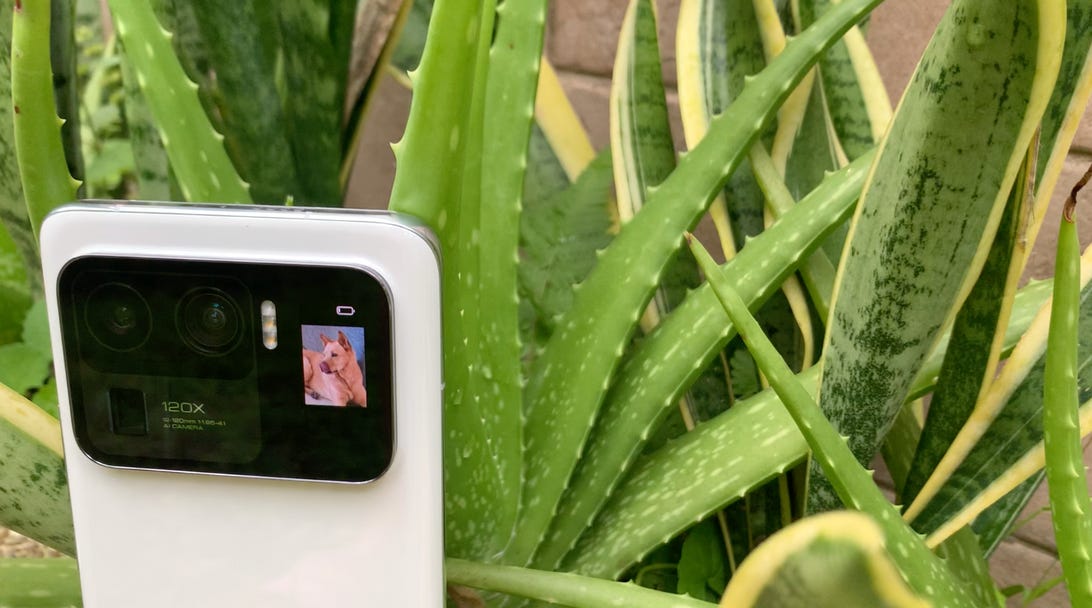
Xiaomi’s Mi 11 Ultra lets you customize the “signature” on its rear display.
Sareena Dayaram/CNETAre two screens better than one? Xiaomi hopes to prove so with the Mi 11 Ultra. Announced last month, it’s the Chinese company’s latest superphone and rounds out its new Mi 11 lineup. With the regular Mi 11, Xiaomi already gave us an excellent device, packing nearly everything we expect from an Android flagship in 2021. But Xiaomi has outdone itself with the Mi 11 Ultra. After a week with the Mi 11 Ultra, I can say Xiaomi has once again leveled up its flagship game by stacking a fabulous array of features — it really left me stunned.
Xiaomi has tons of brag material here. The Mi 11 Ultra has the world’s largest camera sensor, the world’s widest ultrawide camera, one of the brightest screens around, it shoots 8K video on all three cameras, and of course there’s that headline-making second screen on the rear.
But that second display is really just icing on the cake. The Mi 11 Ultra holds its own without it. There’s also a 6.5-inch OLED panel, Qualcomm’s fastest chip, the Snapdragon 888, a sharp and punchy front display, and a loud set of stereo speakers co-developed by Harman Kardon. Xiaomi usually gets a small ding in our coverage for leaving out the IP rating for water and dust resistance, but that’s no longer the case: the Mi 11 Ultra’s IP68 rating means it’s waterproof.
One thing absent in the Mi 11 Ultra is a memory card slot for expandable storage, but this phone has 256GB of storage — at least the European version I was given did — so most won’t need the extra storage, at least not for a while. Models are likely to vary depending on the country.


If I had to nitpick, the Mi 11 Ultra would lose points for not entirely living up to what Xiaomi says it can do, at least in my experience. For instance, Xiaomi markets its second screen as an alternative always-on display, but it can’t actually do that. In fact, the longest it can stay on is 30 seconds. Admittedly, when you’re using it as a viewfinder, you won’t run into this issue. Also, despite the many fancy features Xiaomi can brag about, several of them are gratuitous — but maybe that’s OK, because isn’t that what a superphone is all about?
Either way, there’s no denying this is one of Xiaomi’s smartphone jewels, but you’ll have to import if you want in — there are no plans for a release stateside. You won’t have to buy a Chinese version, which doesn’t have Google, as the Mi 11 Ultra will launch in Europe for 1,119 euros, which converts to $1,435, £970 or AU$1,860. That’s almost exactly the same as the Galaxy S21 Ultra‘s starting price of 1,124 euros, which includes Europe’s 20% sales tax. The S21 Ultra starts at $1,125 for the 256GB version in the US, for comparison.


The rear preview of my selfie.
Sareena Dayaram/CNETMi 11 Ultra design: Business in front, party in the back
The Mi 11 Ultra features the design trappings of a standard Android flagship in 2021 — from the front, at least. It has a hole-punch notch housing the front selfie camera, a gently curved display and ports or buttons in their usual locales. Once you flip this behemoth of a handset over, you won’t miss the standout feature: a second display, living in a supersized camera bump that takes up roughly a quarter of the Mi 11 Ultra’s rear. It’s probably the biggest camera bump I’ve ever seen and eclipses the massive bump seen on 2020’s Galaxy S20 Ultra.
The best use of the 1.1-inch AMOLED screen is to display selfie previews, meaning you have the privilege of using the three higher-resolution cameras, usually reserved for regular photos, to help you nail selfies or group photos. But when the phone’s main screen is facing down, the second screen can display notification alerts from apps like WhatsApp, or show you what audio you’re listening to, or tell you the time. That said, the second display certainly contributes to the Mi 11 Ultra’s weight, which adds up to 234 grams (8.25 ounces), so it probably won’t be comfortable to use one-handed for most people.


Customization suite for the rear display.
Sareena Dayaram/CNETMeanwhile, the front display is the same as on the Mi 11. There’s a 6.81-inch AMOLED with a 120Hz refresh rate, except it’s brighter with a peak brightness of 1,700 nits. Unlike most flagships, which typically use glass shielding, the Mi 11 Ultra has a ceramic rear, which is considered to be more durable than glass. Corning’s tough Gorilla Glass Victus is on the front.
Mi 11 Ultra’s rear display is the icing on the cake
Although phones sporting rear displays do exist (the Nubia Z20, for instance), it’s a rare feature that seems even more unusual considering the Mi 11 Ultra isn’t foldable. Plus it’s the first time I’ve ever used one, so I’m definitely soaking it all in. Customizing the image or signature on the rear display added an extra layer of personalization, a cool touch that made the phone feel even more my own.
At the same time, however, I can’t say I’m convinced the second screen will catch on. It has limitations in its current form. It’s challenging to see any detail when snapping selfies since you’re depending on a tiny display, but it does function as a rough guide. You can only take 15 seconds of video using the selfie viewfinder, and portrait mode can’t be used at all. By the way, the selfie preview feature isn’t part of the default settings, and needs to be switched on from the Special Features menu in settings.


The selfie screen can be customized with images or signatures. It also shows battery life and notifications like incoming calls or messages from apps like WhatsApp.
Sareena Dayaram/CNETMi 11 Ultra has the largest camera sensor on a smartphone right now
The party on the back of the Mi 11 Ultra continues with the stellar camera module, composed of three rear sensors: a 50-megapixel main lens with a 1/1.12-inch sensor; a 48-megapixel ultrawide lens, with a 128-degree field of view; and a 48-megapixel telephoto lens. The 1/1.12-inch sensor on the main camera, Samsung’s GN2, is probably the largest ever on a smartphone. Bigger sensors can let more light enter, helping produce all-around better photos, especially at night. For context, the GN2 sensor is nearly 20% larger than the one on the S21 Ultra, and more than 18% bigger than the one in the iPhone 12 Pro Max.
Those aren’t just numbers: Taking vibrant and detailed photos was effortless. Zoom was impressive too. The Mi 11 Ultra has 120x zoom, which based on the specs at least, means it’s better than the 100x zoom of the Galaxy S21 Ultra, but I didn’t have a Galaxy device on hand to compare. Either way, pictures taken with 120x zoom were a jumble of pixels and entirely unusable. You can get away with crisp photos up until 15x zoom, maybe 20x on a clear day, but after that it gets pretty blurry.


Taken with night mode off.
Sareena Dayaram/CNET

Photo taken with night mode activated. You can see how it brightens up the image and lightens the plant on the bedside table, adding some detail.
Sareena Dayaram/CNET

This camera easily captures photos with lovely depth of field.
Sareena Dayaram/CNET

Selfie taken with the ultrawide camera at night.
Sareena Dayaram/CNET

Hong Kong before sunset. Taken with the ultrawide camera.
Sareena Dayaram/CNET

Taken on default settings.
Sareena Dayaram/CNET

5x zoom.
Sareena Dayaram/CNET

10x zoom.
Sareena Dayaram/CNETAuxiliary features not forgotten
The Mi 11 Ultra is a meticulously designed device, and it’s clear that Xiaomi paid attention to auxiliary features that don’t catch attention on other devices. For instance, the flashlight’s powerful rays beam bright and far thanks to its triple LED lights. Using the Mi 11 Ultra, I managed to make it through an otherwise dark night with limited visibility. I’ve harped on at length before about the Mi 11 lineups’ excellent stereo speakers, so if you want to read about the quality, take a look at my review of the Mi 11. The Mi 11 Ultra uses the same speaker system, co-developed by Harman Kardon.
As has been the case with the rest of the Mi 11 lineup, Xiaomi includes accessories that main rivals Apple and Samsung have removed from their boxes. There’s a 67-watt charger, a plastic case and a USB-C cable inside the Mi 11 Ultra’s black box.
Mi 11 Ultra vs. Samsung Galaxy S21
| Mi 11 Ultra | Galaxy S21 Ultra | |
|---|---|---|
| Display size, type, resolution | Front: 6.81-inch AMOLED display, 3,200×1,440 pixels. Rear: 1.1-inch AMOLED, 294×126 pixels | 6.8-inch Edge Dynamic AMOLED 2X, 3,200×1,440 pixels |
| Pixel density | Front: 515 ppi. Rear: 291 ppi | 515 ppi |
| Dimensions (Inches) | 6.4×2.93×0.32 inches | 2.97×6.5×0.35 inches |
| Dimensions (Millimeters) | 164.3×74.6 x 8.38 mm | 75.6×165.1×8.9 mm |
| Weight ( Grams) | 234g | 229g |
| Mobile software | Android 11 | Android 11 |
| Camera | 50-megapixel (main with 1/1.12-inch sensor), 48-megapixel (ultrawide with 120-degree FOV), 48-megapixel (telephoto) | 108-megapixel (wide), 12-megapixel (ultrawide), 10-megapixel (3x telephoto), 10-megapixel (10x telephoto) |
| Front-facing camera | 20-megapixel | 10-megapixel |
| Video capture | 8K | 8K |
| Processor | Snapdragon 888 | Snapdragon 888 64-bit octa-core processor 2.8GHz (max 2.4GHz+1.8GHz) |
| Storage | 256GB (in Europe) | 256GB, 512GB |
| RAM | 12GB | 12GB, 16GB |
| Battery | 5,000 mAh | 5,000 mAh |
| Fingerprint reader | In-display | In-display |
| Connector | USB-C | USB-C |
| Headphone jack | No | No |
| Special features | Rear display, 120x digital zoom, 5x optical zoom, 5G, 67W wired and wireless charging, 10W reverse wireless, 120Hz display, Samsung GN2 sensor | IP68 rating, 5G-enabled, 100x Space Zoom, 10W wireless charging, 10x optical zoom |
| Price (USD) | Euro price converts to $1,435 (256GB) | $1,200 (128GB), $1,250 (256GB), $1,380 (512GB) |
| Price (GBP) | Euro price converts to £970 (256GB) | £1,329 |
| Price (AUD) | Euro price converts to AU$1,860 (256GB) | AU$1,849 |
























